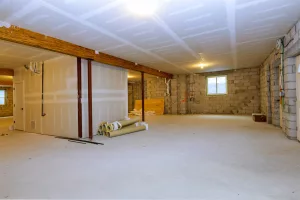What are the Different Basement Types?
All houses listed on the Edmonton Real Estate Board’s MLS have a designated basement type. This term describes what kind of basement a house has. There are a few different kinds of basement out there, and the information is important when shopping for a home or making comparisons between homes.
Real Estate Agent Explains Basement Types
The different kinds of basements are:

| Basement Type | Abbreviation |
| Crawlspace | CRAWL |
| Dugout | DUGOU |
| Full | FULL |
| None | NONE |
| Part | PART |
| See Remarks | REMKS |
| Walkout | WKOUT |
| Walk-up | WKUP |
Crawlspace
Houses with a crawlspace have enough room underneath to crawl or stoop, but certainly not stand up. This is so that you can get access to plumbing pipes or other utilities, and also to provide a more stable foundation for the house than having no basement. Crawlspaces are fully enclosed, but may or may not be heated. Some crawlspaces are large enough and have enough height to make for reasonable storage spaces – although you might not want to store anything down there you will need often.
Full Basement
Full basements are the most common basement type in Edmonton. Full basements are high enough that you can stand up in them. They usually form good living spaces provided the ceiling height is high enough for comfort and they aren’t too damp. Some older homes have full basements that are not high enough for taller people to walk around in comfortably – they would still be considered full basements, though. Full basements are actually defined not only by height, but by how far they extend; a full basement is the full footprint of the house. Another way of saying it is that a full basement will have about the same square footage as the main floor of a house, minus a bit for the thick foundation walls.
No Basement
Almost all homes have some sort of basement. If it is labelled as “none,” it really should have no basement at all, but often this label is incorrectly applied on the MLS system. No basement means that the home is built on a concrete slab (like a garage is), or the floor rests directly on the ground (like a shed would), or sits on pilings like a cabin or mobile home might. Many condos and almost all commercial buildings do not have basements and are sitting on a concrete slab – these buildings will be “no basement” structures. In Edmonton, the vast majority of homes do not fit this category.
Part Basement
Houses with a part basement are homes that usually have additions that have a crawlspace underneath or no basement. That is, the basement does not extend under the entire home. There are many older homes in Edmonton that have part basements. It is not often that a home is built with a part basement, it is usually a situation that arises after additions are made to the home, where the new addition does not include a basement. It is not often that split labels are labelled this way however, even though they sometimes have a crawlspace or no basement under part of the home.
Walkout Basement
Walkout basements are just that – basement that you can walk out of. This designation should be reserved for true walkout basements and not basements that just have a staircase out of them. A walkout basement house is almost always built into a hill. Sometimes this is a natural situation and sometimes a developer will artificially build a hill to place the foundations into – often around a pond or lake. Walkout basements are considered valuable to buyers. Walkout basements are sometimes called walk-in basements. They are considered opposite from a conventional basement where there are no doors to the outside.
Walk-up Basement
Walk-up basements are those that are just like walkout basements, but turned around. That is, the front of the house has a basement entry. These are built into hills as well. They are not very common in homes in Edmonton.
Why Does It Matter?
It’s quite clear that having a basement makes a difference in a home. When you go to sell your home and it has a full-sized basement, you’re going to want to advertise that. If it has a part basement, you don’t want to have anyone expecting it to be the full footprint of the main floor. If there’s no basement at all, a buyer is going to want to know that. Basically your basement type determines whether the basement is the same size as the house, or smaller, or there isn’t one at all. And beyond that a basement that is walk-out or walk-up can mean a separate entrance into the home and a very bright lower level.
For home buyers, understanding basement types can help them select homes from listings that fit their needs and desired lifestyle.

